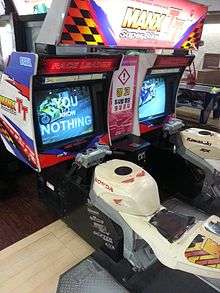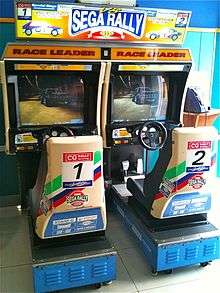Sega AM3
Sega AM Research & Development No. 3[lower-alpha 1], known as Hitmaker Co., Ltd.[lower-alpha 2] from 2000 to 2004, is a defunct division of Sega, a Japanese video game company. Established by 1993, AM3 was managed by Hisao Oguchi and developed a number of arcade titles for Sega. Series introduced by AM3 include Virtual On, Sega Rally, Crazy Taxi, and Virtua Tennis. AM3's main focus was on arcade games until the release of the Dreamcast. Additionally, developers Tetsuya Mizuguchi and Kenji Sasaki developed Sega Rally Championship with AM3 before departing to form AM Annex, which later split into Sega AM9 and Sega AM5.
 Logo used as Hitmaker Co., Ltd. | |
Formerly | Hitmaker Co., Ltd. |
|---|---|
| Division | |
| Industry | Video games |
| Fate | Merged with Sega's Research and Development |
| Founded | 1993 |
| Founder | Hisao Oguchi |
| Defunct | 2009 |
| Headquarters | Japan |
Key people | Tetsuya Mizuguchi Kenji Sasaki Kenji Kanno Mie Kumagai |
| Owner | Sega |
In 2000, Sega reorganized its studios into semi-autonomous companies, and AM3 became Hitmaker. The company expanded its development into Dreamcast games and ports, but saw a reduced amount of success compared to previous years. Oguchi departed Hitmaker in 2003 to become president of Sega. As part of Oguchi's studio consolidation plan with Sega, Sasaki's Sega Rosso studio was merged into Hitmaker. The next year, Hitmaker was integrated back into Sega. The AM3 designation would continue until 2009 until it was merged into other departments.
History
Hisao Oguchi joined Sega in 1984, when there was only one research and development division for arcade and video games. As part of his earliest work, he worked on project planning for the Master System, and his first game developed was Doki Doki Penguin. He also worked as director on Super Derby, as well as Super Monaco GP, Rad Mobile, and Heavyweight Champ. Oguchi worked with Sega AM1 before going to AM3.[1] He was appointed as manager of AM3 a month after it opened.[2]

AM3 opened by April 1993.[2] By May 1993, a new Sonic the Hedgehog arcade project was in development.[3] SegaSonic the Hedgehog was developed by AM3,[4] with assistance from Sonic Team.[5] Over the next four years, AM3 continued to develop new titles, such as Sega Rally Championship, Gunblade NY, Manx TT Super Bike, Virtual On: Cyber Troopers, Last Bronx, and Top Skater.[1] In 1995, Sega Rally was described by Next Generation as being potentially superior to the well reviewed Daytona USA. The same magazine described AM3 as a "fledgling" studio, being Sega's newest arcade development department at the time. Director Kenji Sasaki declared that AM3 "wanted to make a racing game that was very different to all the others out there, while producer Tetsuya Mizuguchi highlighted the game's realistic motion cabinet.[6] Mizuguchi and Sasaki later departed AM3 with the team of Sega Rally Championship[7] to develop Sega Touring Car Championship with their new group, AM Annex.[8]
In a 1997 interview, Oguchi stated that the culture at AM3 was that he would not reject or interfere with ideas, although he would make suggestions. He likened the environment to a university laboratory and called it "the AM3 way". Oguchi also addressed AM3's lack of a genre of game in which they specialized, stating that his department's primary objective was to create games that "look interesting", which also meant a focus on arcade games that one would not find on a video game console. AM3 had a fondness for using the Model 2 arcade system board, which was used on Last Bronx and Top Skater even though the former released just a few weeks before AM2's Virtua Fighter 3 on the Model 3.[1] Top Skater was released afterward with a deliberate selection of the Model 2.[9] Of the newer hardware, Oguchi stated that AM3 would work with it, and that he anticipated it would eventually lower in cost much as the Model 2 had already. Next Generation praised Last Bronx despite comparing it to Virtua Fighter 3, stating it showed how AM3 had a "refusal to take a back seat to AM2 or any other R&D department."[1]

In 1999, AM3 released Top Skater developer Kenji Kanno's Crazy Taxi for the NAOMI system board.[10] It quickly became a staple game at a number of arcades and received a Dreamcast port, which sold over one million copies. Another arcade and home release, Virtua Tennis, helped to start a new wave of tennis video games and became one of the Dreamcast's best sellers.[11] Derby Owners Club proved to be highly influential as an arcade game with physical card features.[12]
Sega restructured its arcade and console development teams into nine semi-autonomous studios headed by the company's top designers in 2000.[13][14] Oguchi chose to name his new company Hitmaker, as "the perfect translation of our image". He expressed a desire to move forward with network gaming and work on new concepts with his staff of 128 employees.[7] The company's official name was Hitmaker Co., Ltd.[15] Into 2001, Hitmaker continued to release arcade and Dreamcast games, including Cyber Troopers Virtual-On Force, Confidential Mission, and Segagaga. Despite these releases being positive, Hitmaker was not reaching the level of success they had before.[11]
In 2003, Oguchi was promoted to president of Sega when Hideki Sato stepped down. At the time, Sega had recently announced their first profit in five years.[16] Virtua Tennis producer Mie Kumagai replaced Oguchi as president of Hitmaker, becoming Sega's first female studio head.[17] Oguchi announced his intention to consolidate Sega's studios into "four or five core operations".[16] As part of the consolidation, Hitmaker absorbed Sega Rosso, which worked on the Sega Rally and Initial D Arcade Stage series.[18] Then, in 2004, Sega reintegrated all of its studios into the company, with Hitmaker shutting down its website on July 1.[15][19] The AM3 designation continued within Sega until April 2009, when the studio was integrated into other departments.[20] According to IGN's Travis Fahs, AM3 was one of Sega's top arcade studios but received little recognition in comparison to AM2.[11] Rob Fahey of Gamesindustry.biz stated that Hitmaker had a strong reputation with consumers and within the industry.[19]
Sega Rosso

Sega Rosso[lower-alpha 3], previously Sega AM5, was a video game development studio headed by Kenji Sasaki, who had served as a designer on Sega Rally Championship. In 1996, producer Tetsuya Mizuguchi met with Hisashi Suzuki, the manager of the R&D division. He and Mizuguchi agreed to create a new department separate from AM3 that would be called AM Annex. Mizuguchi selected the initial team himself, a team of six or seven people that would later grow in number. The first game AM Annex began to develop was Sega Touring Car Championship on the Model 2 arcade board.[21][22] AM Annex later received the AM8 designation and developed Sega Rally 2 and Star Wars Trilogy Arcade on Sega's Model 3 board.[23]
According to Hisao Oguchi, Mizuguchi and Sasaki had departed AM3 with the team of Sega Rally Championship.[22] AM Annex was rebranded as AM12 by September 1998,[24] and AM5 in 1999.[25] The AM5 designation was previously used for a team that designed large attractions for Sega's arcades and indoor amusement parks.[26] Mizuguchi later chose to leave Sasaki after being granted his own department as CS4, later AM9, and even later United Game Artists.[22][27] Sasaki became head of AM5, while the AM8 designation went to Sonic Team.[22][28][29] As the smallest AM department with a staff between 40 and 50 employees, most of Sasaki's staff came from Namco, where Sasaki himself had a role in the development of the Ridge Racer series.[22] AM5 developed Star Wars: Racer Arcade and released it by July 2000.[30]
When the studios were separated from Sega, Sasaki chose the name "Sega Rosso" to have a "hotter" image than the "cool" blue color of Sega, and he liked the combination of Sega with the Italian word for red. Sega Rosso's next three titles were NASCAR Arcade, Card Captor Sakura, and Cosmic Smash. Sasaki expressed a desire to work on both arcade and Dreamcast titles, as the arcade industry was struggling.[22] Sega Rosso would also work on the Initial D Arcade Stage series before being merged with Hitmaker in 2003.[18]
See also
Notes
References
- "NG Alphas: An Interview With Hisao Oguchi". Next Generation. No. 32. August 1997. pp. 54-55. Retrieved April 1, 2020.
- Horowitz, Ken (2018). The Sega Arcade Revolution: A History in 62 Games. McFarland & Company. p. 157. ISBN 9781476631967.
- "Sega, 1993 and Beyond..." Electronic Gaming Monthly. No. 46. May 1993. p. 52. Archived from the original on October 13, 2017.
- Parish, Jeremy (June 5, 2014). "Who Makes the Best Sonic the Hedgehog Games?". USgamer. Archived from the original on August 8, 2017. Retrieved July 17, 2017.
- Dransfield, Ian. "Has a lost Sonic arcade game been unearthed?". DigitalSpy. Archived from the original on July 6, 2017. Retrieved October 12, 2017.
- "AM3". Next Generation. No. 4. April 1995. pp. 70–71.
- "Sega's new beginning". Edge. No. 89. Future plc. October 2000. pp. 68–78.
- "Sega AM Annex". Next Generation. No. 23. Imagine Media. November 1996. pp. 76–79.
- Horowitz 2018, p. 230.
- Horowitz 2018, p. 240-242.
- Fahs, Travis (September 9, 2010). "IGN Presents the History of Dreamcast". IGN. Archived from the original on September 28, 2014. Retrieved October 31, 2014.
- Horowitz 2018, p. 251-252.
- Fahs, Travis (April 21, 2009). "IGN Presents the History of Sega". IGN. Archived from the original on October 31, 2014. Retrieved October 31, 2014.
- Parish, Jeremy (September 3, 2009). "9.9.99, A Dreamcast Memorial". 1UP.com. Archived from the original on February 1, 2014. Retrieved December 10, 2016.CS1 maint: BOT: original-url status unknown (link)
- "Notice on Reorganization of the Company's R&D Subsidiaries" (PDF). www.segasammy.co.jp. Sega Sammy Holdings. May 18, 2004. Archived from the original (PDF) on June 30, 2013. Retrieved January 9, 2018.
- Fahey, Rob (May 20, 2003). "Sega reports a profit, but top execs step down". Gamesindustry.biz. Archived from the original on July 11, 2018. Retrieved April 1, 2020.
- Fahey, Rob (July 3, 2003). "Sega names new HitMaker president". Gamesindustry.biz. Retrieved April 1, 2020.
- Doree, Adam (July 25, 2013). "Sega Studio Mergers: Full Details". Kikizo. Superglobal Ltd. Archived from the original on June 8, 2015. Retrieved March 31, 2020.
- Fahey, Rob (June 29, 2004). "Sega development studios return to the fold". GamesIndustry.biz. Gamer Network. Archived from the original on July 11, 2018. Retrieved July 11, 2018.
- "Game Music Core Special Interview". Game Music Core (in Japanese). April 1, 2009. Archived from the original on September 14, 2019. Retrieved April 1, 2020.
- "Sega AM Annex". Next Generation. No. 23. Imagine Media. November 1996. pp. 76–79.
- "Sega's new beginning". Edge. No. 89. Future plc. October 2000. pp. 68–78.
- "Coming Soon: Star Wars Trilogy Arcade". Sega Saturn Magazine. No. 36. EMAP Ltd. October 1998. pp. 22–25.
- "Sega development studios". Sega Saturn Magazine (in Japanese). Vol. 25. SoftBank Publishing. September 11, 1998. p. 204.
- "Sega development studios". Dreamcast Magazine (in Japanese). Vol. 36. SoftBank Publishing. November 19, 1999. pp. 14–15.
- Horowitz 2018, p. 158.
- "Sega Development Studios". Dreamcast Magazine (in Japanese). No. 36. Soft Bank Publishing. November 1999. p. 13.
- EGM Staff (October 2000). "Sega's R&D Hierarchy". Electronic Gaming Monthly. No. 153. Sendai Publishing. p. 40. ISSN 1058-918X.
- "Sega: On the Rebound or On the Ropes?". Next Generation. No. 68. Imagine Media. October 2000. p. 8. ISSN 1078-9693.
- Woodward, Guy (July 2000). "Star Wars Episode One Racer". Arcade. No. 21. Future Publishing. p. 90.
